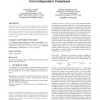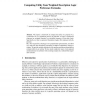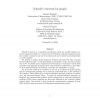11 search results - page 1 / 3 » Inclusion-exclusion formulas from independent complexes |
COMPGEOM
2005
ACM
13 years 6 months ago
2005
ACM
Using inclusion-exclusion, we can write the indicator function of a union of finitely many balls as an alternating sum of indicator functions of common intersections of balls. We...
DALT
2009
Springer
13 years 8 months ago
2009
Springer
We propose a framework to compute the utility of a proposal w.r.t. a preference set in a negotiation process. In particular, we refer to preferences expressed as weighted formulas ...
RANDOM
2001
Springer
13 years 9 months ago
2001
Springer
We consider the problem of determining whether a given function ¢ £ ¤¥ ¦ §¨© ¤¥ ¦ §¨ belongs to a certain class of Boolean functions or whether it is far from the...
STOC
2003
ACM
14 years 5 months ago
2003
ACM
For a Boolean formula on n variables, the associated property P is the collection of n-bit strings that satisfy . We study the query complexity of tests that distinguish (with hig...
CORR
2010
Springer
13 years 2 months ago
2010
Springer
Schaefer's theorem is a complexity classification result for so-called Boolean constraint satisfaction problems: it states that every Boolean constraint satisfaction problem ...



